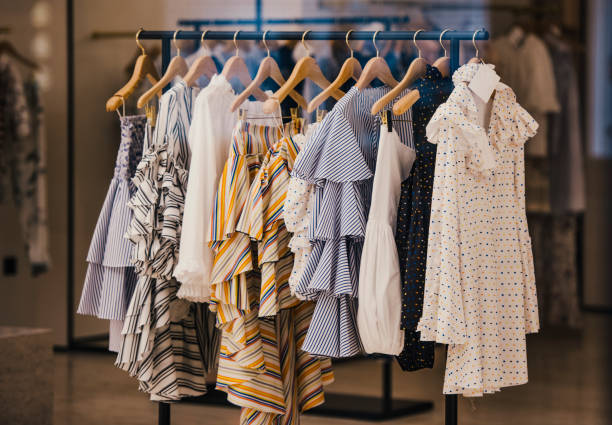The Increase of Online Buying: Finding Boutique Fashion at Your Fingertips
Wiki Article
Checking Out the Advancement and Effect of Clothes on Modern Style Trends
The evolution of garments has considerably affected modern style fads, merging historical precedents with sophisticated developments. Famous numbers like Coco Chanel and Yves Saint Laurent revolutionized the garment industry by presenting principles that prioritize comfort and ease of access, which proceed to reverberate today. Meanwhile, technological strides in areas such as 3D printing and wise fabrics are redefining design opportunities and customer experiences. Additionally, the expanding emphasis on inclusivity and sustainability is reshaping market criteria. As we consider these diverse impacts, one must question exactly how these elements jointly redefine fashion's role in showing and forming modern culture.Historic Fashion Influencers
In the tapestry of fashion history, particular numbers have left an enduring mark, forming the patterns and styles that specify whole ages. Coco Chanel, a cutting edge developer, redefined women's fashion by presenting comfortable, elegant apparel that left from restrictive corsets. Her legendary Chanel fit and little black dress have actually come to be ageless staples in wardrobes worldwide. Similarly, Christian Dior's post-war "New Look" in 1947, with its party of womanhood with full skirts and cinched waists, noted a return to opulence and has actually remained to influence designers.Elsa Schiaparelli is an additional essential number, renowned for her avant-garde layouts that incorporated surrealist art, working together with Salvador Dalí to create whimsical items that tested conventional visual appeals. Her ingenious use color and strong patterns resounds in contemporary fashion. Yves Saint Laurent, at the same time, democratized haute couture with prêt-à-porter collections, bringing path designs to the masses and setting a precedent for contemporary ready-to-wear lines.
These dreamers, among others, not only changed fashion in their times however additionally established enduring patterns that reverberate in today's fashion business, supplying a structure upon which contemporary developers remain to introduce and develop. Their heritages underscore the importance of imagination and bold in fashion's ever-evolving story.
Technical Developments in vogue
Amidst the dynamic landscape of the apparel industry, technical developments stand at the leading edge of development, improving just how designers develop and consumers engage with fashion. The assimilation of 3D printing has reinvented layout procedures, enabling designers to try out intricate frameworks and sustainable materials that were previously inconceivable. This technology facilitates rapid prototyping, reducing waste and speeding up production times.
Smart fabrics, installing innovation into textiles, are additionally changing the industry. Technologies like temperature-regulating and self-cleaning textiles supply boosted performance and convenience. Wearable technology, incorporating functions like physical fitness tracking and communication, adds a brand-new measurement to style, merging aesthetics with practicality.
Cultural Shifts and Style
As technological improvements proceed to improve the fashion business, cultural shifts are equally prominent, redefining style and consumer preferences. In current years, the increase of social media sites systems has actually increased the circulation of international fashion trends, allowing diverse cultural influences to converge and exist together. This electronic interconnectivity has promoted the rapid exchange of concepts, causing a more diverse and inclusive analysis of design that reflects the complex nature of modern society.Cultural awareness and gratitude have triggered developers to attract ideas from a more comprehensive spectrum of ethnic and historical contexts, incorporating standard concepts with contemporary visual appeals. This blend has actually resulted in fashion that resonates with a larger audience, advertising a sense of identity and belonging throughout various demographics. Additionally, the boosting demand for customization has actually driven brand names to supply personalized alternatives, enabling customers to share uniqueness while showing their cultural heritage.
In addition, changing social values have affected fashion, with inclusivity and variety becoming main themes. The sector has started to accept models web and influencers of numerous body types, ethnicities, and sex identities, difficult conventional elegance criteria. This makeover highlights the power of cultural changes fit the future of style, as design becomes a more genuine expression of individual and collective identification.
Sustainability and Modern Layout
While the style industry proceeds to advance, the crucial for sustainability has actually ended up being increasingly urgent, influencing modern design practices. The rise of slow fashion, which emphasizes quality over quantity, urges customers to spend in classic items instead than transient trends.In addition, modern-day layout is defined by its advancement in lessening waste and advertising circularity. This technique not only mitigates ecological influence yet also boosts the social obligation of fashion houses.

Future Trends in vogue

Sustainability will certainly remain to be a driving force in shaping future style patterns. The industry is increasingly adopting environment-friendly products and moral manufacturing approaches, replying to a growing consumer demand for liable techniques. Advancements such as bio-fabricated products and closed-loop recycling systems are set to redefine just how garments is produced and taken in, reducing ecological impact while keeping style and quality.
Cultural changes, consisting of the increase of inclusivity and variety, will certainly also play an essential Find Out More function. As culture comes to be more mindful of social issues, style is anticipated to become a system for expression and adjustment. Designers will likely concentrate on creating collections find out here that show a more comprehensive variety of experiences and identifications, championing representation and access.
Conclusion
The development of apparel considerably affects modern-day fashion trends, where historical impacts combine with contemporary layouts. Trick numbers like Coco Chanel and Yves Saint Laurent have redefined style, while technical technologies such as 3D printing and smart textiles broaden innovative opportunities. Social changes towards inclusivity and sustainability oblige brand names to accept and take on moral practices diversity. This ongoing evolution highlights style's function as a mirror to social worths and technical development, recommending a future abundant with technology and inclusivity.The development of garments has actually dramatically affected modern-day style patterns, merging historical criteria with cutting-edge developments.In the middle of the dynamic landscape of the fashion sector, technical innovations stand at the center of technology, improving exactly how designers develop and consumers engage with style.While the fashion industry proceeds to progress, the imperative for sustainability has actually come to be increasingly immediate, affecting contemporary design techniques. As sustainability ends up being embedded in modern-day style, it leads the method for a more liable and mindful fashion sector.
The development of clothing significantly affects modern style trends, where historic influences combine with contemporary styles.
Report this wiki page